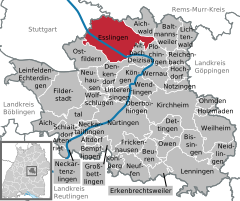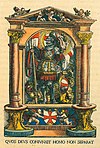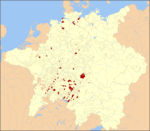world.wikisort.org - Germany
Esslingen am Neckar (Swabian: Esslenga am Neckor) is a town in the Stuttgart Region of Baden-Württemberg in southern Germany, seat of the District of Esslingen as well as the largest town in the district. Within Baden-Württemberg it is the 11th largest city.
Esslingen am Neckar | |
|---|---|
Town | |
 | |
 Coat of arms | |
Location of Esslingen am Neckar within Esslingen district  | |
 Esslingen am Neckar  Esslingen am Neckar | |
| Coordinates: 48°44′0″N 9°19′0″E | |
| Country | Germany |
| State | Baden-Württemberg |
| Admin. region | Stuttgart |
| District | Esslingen |
| Government | |
| • Mayor (2017–25) | Matthias Klopfer[1] (SPD) |
| Area | |
| • Total | 46.43 km2 (17.93 sq mi) |
| Elevation | 241 m (791 ft) |
| Population (2020-12-31)[2] | |
| • Total | 92,722 |
| • Density | 2,000/km2 (5,200/sq mi) |
| Time zone | UTC+01:00 (CET) |
| • Summer (DST) | UTC+02:00 (CEST) |
| Postal codes | 73701–73734 |
| Dialling codes | 0711 |
| Vehicle registration | ES |
| Website | www.esslingen.de |
It is located on the river Neckar, about 14 kilometres (9 miles) southeast of Stuttgart city center. The regions surrounding the city of Esslingen are also mostly developed.
Esslingen was a free imperial city for several centuries until it was annexed by Württemberg in 1802.
The German Timber-Frame Road passes through the city.
History
Prehistoric times
There is archaeological evidence that what is now the city of Esslingen was settled since the Neolithic period. Traces of human settlement found at the site of the city church date back to around 1000 B.C.
Roman times
In the 1st century AD the Esslingen region became part of the Roman Empire. During this period a Roman warehouse was located in the area of Oberesslingen. The nearest major Roman settlements and garrisons were at Cannstatt and Köngen.
Migration and Merovingian period
There are so far no findings from the early Alemanni period, which do exist on the Filder (uplands) nearby. There are findings in Rüdern which suggest a rich grave with eastern influence, including, for example, a set of three-winged spear heads. The ending "-ingen" indicates a group of people wherein a man named Azzilo, Hezzilo or Hetsilo was landlord and family patriarch played an influential role. This means the city's name originally meant: "the peoples of Azzilo". This name, for the first time documented in 856 as Ezlinga and 866 as Hetsilinga ended up becoming today's Esslingen.
In the 6th century, the Alemanni were subjugated by the Merovingians under king Clovis I. But they still took over administrative tasks and formed a Duchy in Francia. In the 8th century they tried to become sovereign again. But the attempt failed near Cannstatt. The end of the Alemannian duchy was marked with the Council of Cannstatt.
In an excavation by Günter Fehring, the remains of the Vitalis-Cella under the church St. Dionysius were uncovered. Proof of settlement dates back to the late Merovingian period. Even older are the single row graves in Oberesslingen and Sirnau.
Middle Ages
Esslingen was first mentioned in 777 as Ezelinga in the last will of Abbot Fulrad from Saint-Denis (near Paris), the chaplain of Pippin and Charlemagne. He bequeathed the church sixth cell upon the river Neckar to his monastery, Saint-Denis. He also brought the bones of Saint Vitalis to Esslingen, which made it a destination for pilgrims and led to its growth.

Around 800 Esslingen became a market town, its market rights being certified in 866. In 949–953 it was a possession of Liudolf, Duke of Swabia. Esslingen received city rights in 1229 under Emperor Frederick II. During the same period the still-extant Neckar bridge was built, making Esslingen a major center for trade on the route between Italy, Switzerland, and northern Germany. Taxes provided by the bridge and market led to further growth of the town, as did the export of the highly regarded wines from the region.
The period between the 13th century and 16th century saw many conflicts between the Free Imperial City and the Counts of Württemberg (later Duchy of Württemberg). About half the population lost their lives in the Thirty Years War between 1618 and 1648 through famine or epidemics. Esslingen lost its independence as an Imperial city during the Napoleonic era in 1802–1803, becoming part of the Duchy of Württemberg.
19th century to Present
The beginning of the 19th century was characterized by industrialization. Glove manufacturing, food processing, textiles, and metal working were early industries in Esslingen. On 20 November 1845 the first train ran from Cannstatt to Esslingen station.
Esslingen was occupied by U.S. troops starting in April 1945, at the very end of World War II. During the war the city suffered very little damage, and it was peaceably surrendered to the approaching allied forces, thus the medieval character of its city center has been mostly preserved.
After the Second World War about 47,000 people moved to Esslingen, mostly refugees and displaced persons from East Germany. Housing developments in Oberesslingen and Zollberg were created to overcome the shortage of housing.
In 1973 Nürtingen district was merged with Esslingen am Neckar, making Esslingen the seat of a much enlarged district.
Largest groups of immigrants by 31.12.2020 :
| 4,182 | |
| 3,030 | |
| 2,051 | |
| 1,711 | |
| 1,248 | |
| 1,102 | |
| 784 | |
| 713 | |
| 708 | |
| 472 |
Transport
Air transport
Stuttgart Airport, the largest airport in Baden-Württemberg, is located in the Esslingen District, roughly ten kilometers south of the town, on the border with the town of Leinfelden-Echterdingen. A plane owned by Lufthansa has been named after the town.
The junction on the Bundesautobahn 8 Karlsruhe-Munich which serves Esslingen is just after the airport when traveling towards Munich.
Road Transport
Esslingen is directly on the B10 State Highway which runs as a dual carriageway from Stuttgart to Süßen, and continues onward to Ulm. The exit for Esslingen, just after the B10 passes under the ancient Pliensau Bridge, is particularly unusual, because in the direction of Ulm there are two entry and exit points to the dual carriageway. This makes it is possible to reach the center of Esslingen directly from Stuttgart, and to drive from central Esslingen directly onto the Dual Carriageway in the direction of Ulm without having to pass traffic lights.
Despite the six to eight lanes on the new Pliensau Bridge and the surrounding roads, the infrastructure around Pliensauvorstadt and the route to Zollberg still suffers from frequent congestion.
Esslingen is also on the German Timber-Frame Road.
Long Distance Rail Transport
Esslingen (Neckar) station is on the Fils Valley Railway and is served by line S 1 of the Stuttgart S-Bahn and regional services. The town is on the main rail line between Stuttgart and Ulm, operated by Deutsche Bahn, the main German rail operator. In 2009, the company named a high speed 'Intercity-Express' train "Esslingen-am-Neckar".
S-Bahn
The Stuttgart S-Bahn line S1 which operates between Kirchheim-unter-Teck and Herrenberg via Stuttgart centre, serves the stations of Mettingen, Esslingen (Neckar), Oberesslingen and Esslingen (Zell). Under the planned rebuilding of the railways in central Stuttgart under the Stuttgart 21 scheme, the S1 will be shortened to operate from Kirchheim unter Teck as far as Stuttgart Schwabstraße station.
Direct bus connection to Stuttgart Airport
To avoid the long S-Bahn route to the airport via Stuttgart, the Bus 122, operated by the END Company, now runs directly from the central bus and rail interchange to the airport via Ostfildern Scharnhausen.
Urban Tramway
The Esslingen Urban Tram system was opened in May 1912 and closed on 7 July 1944 after 32 years of operation. It was replaced by trolley buses. The operating company, the Esslinger Städtische Straßenbahn (ESS, translated Esslingen Town Tramway) changed its name in 1944 to the Städtischer Verkehrsbetrieb Esslingen (SVE, or "Esslingen Transport Company").
Former Interurban Tram
On 18 December 1926 the Esslingen-Nellingen-Denkendorf (END) interurban tram began operating. This was the last tram system to be built in Germany before the wave of closures later in the century: after this date permission from the authorities was only given for extensions to existing systems. The tram had to negotiate a five kilometer gradient out of the Neckar Valley to reach the towns and villages of the Eastern Filder region. In total, the system transported 153 million passengers from Denkendorf and later from Neuhausen to Esslingen, and took delivery of two new open trams in 1958. The line was discontinued in February 1978.
Trolley bus and diesel bus
Esslingen, along with Solingen and Eberswalde, is one of the last three German towns which still use trolleybuses. The SVE currently operates two lines using electric power:
101: Oberesslingen Lerchenacker Endstation – Esslingen railway station – Stuttgart-Obertürkheim station.
118: Esslingen Railway Station – Zollberg.
Apart from this around 50 taxis operate in the town.
Car-Sharing
In 1994 A car-sharing company opened a station in Esslingen.
Rebuilding of bus/rail interchange
An ambitious redevelopment project has been in progress since 2004 in the area near the railway station. The current phase of this project is a large redevelopment of the station forecourt costing about 7.4 million Euros. The Baden-Württemberg State Environment and Transport ministry helped fund this with a grant of 4.9 million Euros. During 2009 the Neckarstraße was diverted along unused land on the railway station and lengthened to the west of the site. The next phase, completed in November 2014, was a large-scale redevelopment of the station forecourt to create a bus and rail interchange.
Hochschule Esslingen
The city is home to the Esslingen University of Applied Sciences (German: Hochschule Esslingen). It is known for its mechanical engineering and automotive engineering courses, and also for its three international master's programs (MBA in International Industrial Management,[3] MEng in Automotive Systems,[4] MEng in Design and Development in Automotive and Mechanical Engineering),[5] which are organised by the Esslingen Graduate School[6] and taught completely in English.
Twin towns – sister cities
Esslingen am Neckar is twinned with:[7]
 Coimbatore, India
Coimbatore, India Eger, Hungary
Eger, Hungary Maladzyechna, Belarus
Maladzyechna, Belarus Neath Port Talbot, Wales, United Kingdom
Neath Port Talbot, Wales, United Kingdom Norrköping, Sweden
Norrköping, Sweden Piotrków Trybunalski, Poland
Piotrków Trybunalski, Poland Schiedam, Netherlands
Schiedam, Netherlands Sheboygan, United States
Sheboygan, United States Udine, Italy
Udine, Italy Velenje, Slovenia
Velenje, Slovenia Vienne, France
Vienne, France
Notable people



- Richard Baum (1902–2000), musicologist and music historian
- Thommie Bayer (born 1953), writer, musician and painter
- Otto Borst (1924–2001), German historian
- Karl Deffner (1817–1877), manufacturer, member of parliament
- Cristian Fiél (born 1980), Spanish-German football player
- Isabelle Faust (born 1972), Violinist
- Albert Günther (1830–1914), British zoologist, born in Esslingen
- Volker Hauff (born 1940), German politician, former Member of Bundestag, former Lord Mayor of Frankfurt am Main (SPD)
- Wolfgang Fritz Haug (born 1936), philosopher
- Otto Hauser (born 1952), German politician (CDU), former Member of Bundestag and retired parliamentarian secretary of state
- Walter Hirrlinger (born 1926), German politician (SPD), Member of Landtag, minister of economy, 1990–2008 president of Sozialverband VdK Deutschland, 1953 to 1968 member of local council in Esslingen
- Wilhelm Christian Hochstetter (1825–1881), botanist, university gardener and inspector of the botanical garden in Tübingen
- Ferdinand von Hochstetter (1829–1884), geographer, geologist and natural scientist
- Johann Eberhard Ihle (1727–1814), painter
- Emil von Kessler (1813–1867), founder of the Maschinenfabrik Esslingen (locomotive factory)
- Emil von Keßler jun. (1841–1895), German entrepreneur and politician, director of Maschinenfabrik Esslingen, son of Emil von Keßler
- Georg Christian von Kessler (1787–1842), founder of the still existing sparkling wine cellar Kessler Sekt
- Hermann Kurz (1813–1873), poet, author and translator, father of Isolde Kurz
- Alfred Leikam (1915–1992), notary, politician and mayor, Righteous among the Nations
- Karl Mayer (1819–1889), politician, member of parliament and parliamentary deputy
- Otto Merz (1889–1933), race car driver
- Julius Motteler (1838–1907), leading member of the early German workers' movement, Reichstag deputy
- Wilhelm Murr (1888–1945), German politician (NSDAP), Gauleiter
- Georg Restle (born 1965), journalist
- Paula Rueß (1902–1980), German resistance fighter (French Resistance) and feminist
- Thomas Ruf (1911–1996), German politician (CDU), Member of Bundestag district Esslingen
- Max Sailer (1882–1964), car racing driver and engineer
- Heinrich Schickhardt (1558–1635), builder
- Louis Schlegel (1858–1929), German politician (SPD), Member of Reichstag and Landtag
- Ronja Schmitt (born 1989), German politician (CDU), Member of Bundestag
- Jakob Ferdinand Schreiber (1809–1868), founder of J.F.Schreiber, a publisher known for its children books
References
- Aktuelle Wahlergebnisse, Staatsanzeiger, accessed 12 September 2021.
- "Bevölkerung nach Nationalität und Geschlecht am 31. Dezember 2020" [Population by nationality and sex as of December 31, 2020] (CSV). Statistisches Landesamt Baden-Württemberg (in German). June 2021. Retrieved 17 October 2021.
- "MBA in International Industrial Management". Graduate-school.de. Retrieved 16 April 2013.
- "MEng in Automotive Systems". Graduate-school.de. Retrieved 16 April 2013.
- "MEng in Design and Development for Mechanical and Automotive Engineering". Graduate-school.de. 8 April 2013. Retrieved 16 April 2013.
- "graduate-school.de". graduate-school.de. 8 April 2013. Retrieved 16 April 2013.
- "Esslingen und seine Partnerstädte". esslingen.de (in German). Esslingen am Neckar. Retrieved 30 November 2019.
External links
- Official website (in German)
- City Portal (in German)
- Esslingen University of Applied Sciences (in German and English)
На других языках
[de] Esslingen am Neckar
Esslingen am Neckar ([.mw-parser-output .IPA a{text-decoration:none}ˈɛslɪŋən], schwäbisch Esslenga [ˈeslẽŋɐ]), bis 16. Oktober 1964 amtlich Eßlingen am Neckar, etwa zehn Kilometer südöstlich der Stadtmitte von Stuttgart und inmitten der gleichnamigen Region gelegen, ist Große Kreisstadt und zugleich die zweitgrößte Mittelstadt Baden-Württembergs sowie dessen elftgrößte Stadt.[2] Sie ist Sitz des Landratsamtes und auch größte Stadt des Landkreises Esslingen. Für die umliegenden Gemeinden bildet Esslingen ein Mittelzentrum. Die Einwohner haben den Necknamen Zwieblinger.- [en] Esslingen am Neckar
[es] Esslingen am Neckar
Esslingen am Neckar es una ciudad alemana de la región de Stuttgart, dentro del estado federado de Baden-Wurtemberg, siendo la capital del distrito de Esslingen. Su población ascendía en 2002 a 91 239 habitantes. Se encuentra a orillas del río Neckar, a 10 km del centro urbano de Stuttgart.[ru] Эслинген-ам-Неккар
Эслинген-ам-Неккар[1] (нем. Esslingen am Neckar) — город в Германии, районный центр, расположен в земле Баден-Вюртемберг. Подчинён административному округу Штутгарт. Входит в состав района Эслинген. Занимает площадь 46,43 км² и подразделяется на 24 городских района. Официальный код — 08 1 16 019. Население составляет 94 145 человек.Другой контент может иметь иную лицензию. Перед использованием материалов сайта WikiSort.org внимательно изучите правила лицензирования конкретных элементов наполнения сайта.
WikiSort.org - проект по пересортировке и дополнению контента Википедии


